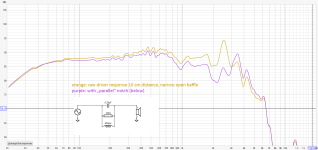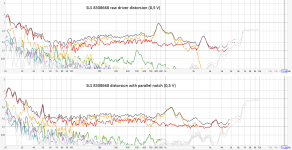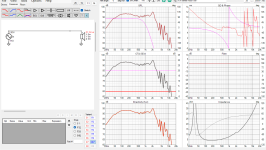Hello. I am struggling to decide which of these woofers to pick for a 2 way crossed at ~1-1.4KHz. I'm specifically interested in which will handle the midrange better. Thoughts? (Tweeter is Peerless DFM 2535R00)
https://www.parts-express.com/pedocs/specs/264-1110-tymphany-sls-p830668-spec-sheet.pdf
https://www.parts-express.com/pedocs/specs/295-658--dayton-audio-sig270-4-specification-sheet.pdf
https://www.parts-express.com/pedocs/specs/264-1110-tymphany-sls-p830668-spec-sheet.pdf
https://www.parts-express.com/pedocs/specs/295-658--dayton-audio-sig270-4-specification-sheet.pdf
Last edited:
Hello Good question I own and use the 830668, good for the price but an old technology driver compare to the sig270.
If you don't have problem with alu cone not like me, the sig270 should have a cleaner midrange.
The SLS830668 is a subwoofer but the midrange is good for this driver, a good bang fro the buck.
Hope this helps.
If you don't have problem with alu cone not like me, the sig270 should have a cleaner midrange.
The SLS830668 is a subwoofer but the midrange is good for this driver, a good bang fro the buck.
Hope this helps.
SIG 270 has a strong first breakup peak at 2 kHz about 8 dB above average response, also very visible in the waterfall plot (in the german HOBBY HIFI magazine). This also shows up as a H3 distorsion peak at ~700 Hz (1% at 90 dB). I would not cross this driver over above 500 Hz or so.for a 2 way crossed at ~1-1.4KHz.
The SLS 830668 has slightly less severe breakup peaks above 1,8 - 2 kHz.
This is my very rough 10 cm "midfield"-measurement, also including a test with parallel notch as proposed by purifi.
The 1 kHz is probably just a "midfield" measurement artefact.

distorsion (red is H2, yellow H3, green H5):

I am not sure I would use this driver up to 1 kHz either.
But I keep thinking about doing this myself, definitely including some kind of distorsion minimizing notch circuit!
Maybe also the dayton breakup peak can be tamed similarly.
Last edited:
At those frequencies you will be edging into the region of narrowing directivty before you reach breakup so I expect if you're crossing to a direct radiator you'd already be watching how fast you cross.
Plan is to cross to a CD in a horn/wgAt those frequencies you will be edging into the region of narrowing directivty before you reach breakup so I expect if you're crossing to a direct radiator you'd already be watching how fast you cross.
Even more so then 😉
The way to handle this is find the driver that matches the narrowing in a way that meets your waveguide, while not getting tangled in it's own breakup so that you can cross that out. Breakup peaks are not a problem since they can be straightened out, but only if they don't exist at the expense of other angles.
The way to handle this is find the driver that matches the narrowing in a way that meets your waveguide, while not getting tangled in it's own breakup so that you can cross that out. Breakup peaks are not a problem since they can be straightened out, but only if they don't exist at the expense of other angles.
I am thinking of using the ST260/B. I already have a pair of DFM 2535R00's. Kinda tricky to find good directivity data on most 10" woofers. Would welcome any other suggestions. Nothing too pricey though..
Considering the purifi article stv shared, I think I'm gonna try the Sig270. I played around with the manufacturer provided frd/zma in vituixcad, and think it should be doable to tame that peak at 2k, though even unsmoothed the manufacturer provided measurements the peak isn't quite as pronounced as third party. We'll see. Decay looks pretty good below 2k on the sig270. I'm optimistic about its application in a 2 way
Biggest concern for me is the big H3 distortion peak at 700Hz stv mentioned, and if it can be satisfactorily attenuated. That series notch method is new to me, and very exciting if broadly applicable, as it really expands options for pushing drivers past their normal limits
The H3 peak around 700 Hz is a direct result of the 2 kHz response peak:big H3 distortion peak at 700Hz stv mentioned, and if that can be satisfactorily attenuated
700 Hz * 3 = 2100 Hz
So if you tame the 2 kHz peak you also reduce H3 at 700 (or 666) Hz.
Understood. I meant to convey that I hope it will be reduced enough for my peace of mindThe H3 peak around 700 Hz is a direct result of the 2 kHz response peak:
700 Hz * 3 = 2100 Hz
So if you tame the 2 kHz peak you also reduce H3 at 700 (or 666) Hz.
I'm sorry, but this did not happen in my use of the SIG180-4 in my Hancocks build. The 2k and 3k suppression did not alleviate the 3rd order rise around 800Hz. The 3rd order rise is below 1% HD, and honestly, I can't hear its interference. I honestly really like these woofers, and I feel the SIG270 would likely be up to the task. They put forth a realistic tuneful bass and midbass range. I also recently did a 10" 2way with the RST28 and the SD270A-88 (Pangolins). Knowing how this went, I feel that if you do your diligence in the xover that your direction should be okay. The SIG drivers are a bit different in how the breakup is generated or inherently suppressed, so it might sound a bit different than measure.
I wouldn't say broadly. Firstly, the distortion has to be significant before it is worth worrying about.That series notch method is new to me, and very exciting if broadly applicable,
Secondly, a breakup peak at 0 degrees may have a related dip at a nearby angle. Geometrically, 0 degrees is not a significant contributor to power which is why straight on isn't the usual choice for the listening angle, and this shouldn't be an issue.
Also, when there's such a difference between angles that region should be crossed out altogether.
I have two SIG270-4 drivers in boxes with Eminence EPSD2002Sa-8 crossed at 1400Hz. I built the first prototype last year and had it crossed at 1600Hz, then I tried 1400 and 1200Hz, but having the woofer handle up to 1400Hz sounds better to my ears than letting the compression driver handle down to 1200Hz so that's where it's crossed at now - 1400Hz. The Eminence EPSD2002Sa-8 compression drivers sit in Dayton H6512 wave-guides. This driver combo having such different sensitivities - around 90 and 106db is probably only suitable for a DSP crossover. Perhaps someone more experienced can say more on this if it is of interest.
The crossover is handled by EquilizerAPO before amplification on my computer. I'm not sure if those are Bessel or Butterworth filters that EquilizerAPO has that are called simply "low-pass" and "high-pass," but that's what I used at first and my ears hurt though a colleague from work said he did not experience it so I guess mine are more sensitive than his. I also tried stacking several of these filters. One day I thought to simply try equalizing the drivers down at crossover frequency by 90db and my ears hurt no more. That's how I have had it since.


Brutal isn't it? But it works and my ears don't hurt so that's good enough for me. There's more to the crossover, but the important part is that the woofer seemed to work fine crossed at 1200, 1400 and 1600Hz. (at least to my ears) I don't know the SLS 830668 or the Peerless DFM 2535R00 so I cannot speak as to if the SIG270-4 or the other woofer is a better choice.
Here's a picture of one of the speakers I've built.

Stands roughly 52cm tall and has a net internal volume in the vicinity of 46 Liters.

I got the impression that the SIG270-4 can benefit from a larger box because it lost of some it's base after I put in damping material. Eventually I took out accustilux and left only the Jantzen 8mm felt that I'd dampened it with. These measurements are of the driver combo I have in the box that I've made and are probably highly inaccurate. (room modes, reflections, maybe the cheap 50W amp that I used for testing impacted this as well) Port resonance is probably accurate. 😅 That being said I plugged the ports with accustilux and couldn't discern any difference except loosing base. Could also be it didn't remove the resonance - I don't know.
I'm curious as to what this woofer can do in a bigger box.
Recently I found this 3-way that uses the SIG270-4. If you're concerned about a problem at 700Hz maybe a 3-way like this or similar with SIG270-4 crossed at 400Hz is something to consider.
The crossover is handled by EquilizerAPO before amplification on my computer. I'm not sure if those are Bessel or Butterworth filters that EquilizerAPO has that are called simply "low-pass" and "high-pass," but that's what I used at first and my ears hurt though a colleague from work said he did not experience it so I guess mine are more sensitive than his. I also tried stacking several of these filters. One day I thought to simply try equalizing the drivers down at crossover frequency by 90db and my ears hurt no more. That's how I have had it since.
Brutal isn't it? But it works and my ears don't hurt so that's good enough for me. There's more to the crossover, but the important part is that the woofer seemed to work fine crossed at 1200, 1400 and 1600Hz. (at least to my ears) I don't know the SLS 830668 or the Peerless DFM 2535R00 so I cannot speak as to if the SIG270-4 or the other woofer is a better choice.
Here's a picture of one of the speakers I've built.
Stands roughly 52cm tall and has a net internal volume in the vicinity of 46 Liters.
I got the impression that the SIG270-4 can benefit from a larger box because it lost of some it's base after I put in damping material. Eventually I took out accustilux and left only the Jantzen 8mm felt that I'd dampened it with. These measurements are of the driver combo I have in the box that I've made and are probably highly inaccurate. (room modes, reflections, maybe the cheap 50W amp that I used for testing impacted this as well) Port resonance is probably accurate. 😅 That being said I plugged the ports with accustilux and couldn't discern any difference except loosing base. Could also be it didn't remove the resonance - I don't know.
I'm curious as to what this woofer can do in a bigger box.
Recently I found this 3-way that uses the SIG270-4. If you're concerned about a problem at 700Hz maybe a 3-way like this or similar with SIG270-4 crossed at 400Hz is something to consider.
Last edited:
Just playing around with manufacturer data, and sure enough with the series notch you do see a big speaker source impedance peak at 2k, using the method the Purifi post mentioned of rearranging the source location in VituixCAD. Guess the only way to see its impact on that 700Hz H3 peak is to try it out!
Attachments
Last edited:
What is the volume of your boxI'm curious as to what this woofer can do in a bigger box.
I calculate ~49,5 Liters. So the net internal volume is in the vicinity of 46L drivers, port, brace etc. internals volume subtracted.What is the volume of your box
Here's a measurement with dampening material as the one in post #16 is without. Note, that this is probably not an accurate measurement ether, but perhaps it is enough to get some idea about the woofer's behavior in a box sized as mine is.
Last edited:
- Home
- Loudspeakers
- Multi-Way
- SLS 830668 vs Sig270 XO 1KHz?


